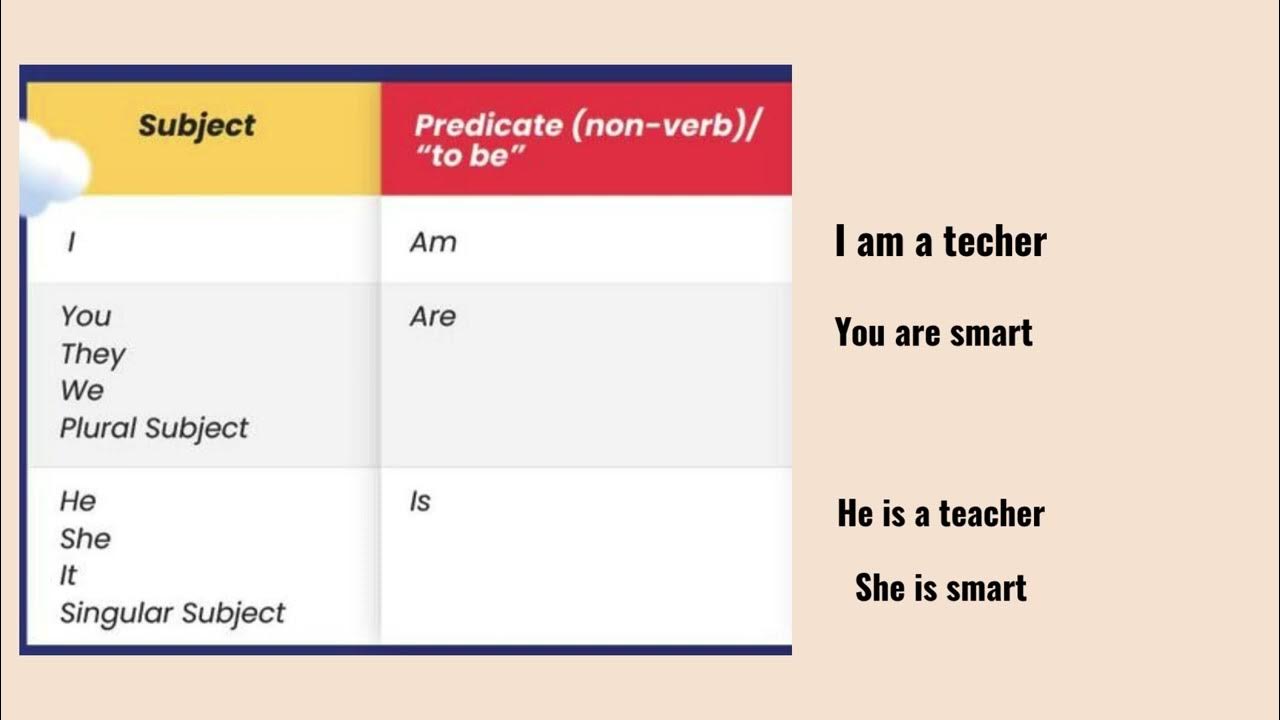Aprenda o VERBO TO BE! | Aula 01 - English in Brazil
Summary
TLDRIn this engaging English lesson, the teacher introduces the verb 'to be' and its various forms (am, is, are) used in the present tense. The lesson highlights the importance of pronouns, providing examples through a fun dialogue between a traveler and the Queen. It also explains contractions, negations, and how to form questions with 'to be'. The lesson includes a quiz to reinforce learning and encourages interactive participation. By the end, learners will understand how to use 'to be' in everyday sentences and be ready for future lessons on more advanced tenses.
Takeaways
- 😀 The verb 'to be' is one of the most important and frequently used verbs in English.
- 😀 'To be' can mean 'to exist' or 'to describe' something or someone, and it has multiple forms in the present tense.
- 😀 In the affirmative form, 'to be' is used as 'I am', 'you are', 'he/she/it is', 'we are', and 'they are'.
- 😀 Contractions are commonly used in informal speech, such as 'I'm', 'you're', 'he's', 'she's', 'we're', and 'they're'.
- 😀 To make negative sentences, add 'not' after the verb, e.g., 'I’m not', 'you aren't', 'he isn't', 'they aren't'.
- 😀 The interrogative form of 'to be' is created by inverting the subject and the verb, e.g., 'Are you?', 'Is she?', 'Are they?'.
- 😀 The lesson includes a dialogue between a traveler and the Queen of England, demonstrating how 'to be' is used in context.
- 😀 The pronouns used with 'to be' are: I, you, he, she, it, we, and they, each taking different forms of the verb depending on the subject.
- 😀 'To be' can have different meanings based on context, such as 'I am a student' (identity) or 'I am thirsty' (state).
- 😀 An interactive quiz was included to test understanding, encouraging students to practice forming correct questions and negative statements with 'to be'.
Q & A
What is the focus of this English lesson?
-The lesson focuses on teaching the verb 'to be' in the present tense, including its affirmative, negative, and interrogative forms, with practical examples and a fun narrative involving a traveler and the Queen.
What are the different forms of the verb 'to be' used in the present tense?
-The forms of the verb 'to be' in the present tense are 'am,' 'is,' and 'are.' 'Am' is used with 'I,' 'is' is used with 'he,' 'she,' or 'it,' and 'are' is used with 'you,' 'we,' and 'they.'
How can you form negative sentences with the verb 'to be'?
-To form negative sentences, add 'not' after the verb 'to be.' For example, 'I am not hungry' or 'They are not in England.' The negative form can also be contracted, such as 'I'm not' or 'They're not.'
How do you form questions with the verb 'to be'?
-To form questions, invert the subject and the verb 'to be.' For example, 'She is a queen' becomes 'Is she a queen?' Similarly, 'They are in England' becomes 'Are they in England?'
What does the verb 'to be' mean in English?
-The verb 'to be' can mean 'to be' or 'to exist.' It is used to describe identity, state, or condition, such as 'I am thirsty' or 'She is a queen.'
In the script, how does the verb 'to be' appear in different contexts?
-The verb 'to be' is used to describe states of being, such as 'I am thirsty' (state) or 'She is a queen' (identity). It can also be used to indicate location or presence, like 'They are in England.'
What is the significance of the Queen's dialogue in the lesson?
-The Queen's dialogue is used to demonstrate how the verb 'to be' is applied in real-life, conversational contexts. It helps learners see the verb in action while also highlighting the use of pronouns and sentence structure.
Why is the verb 'to be' considered the most important verb in English?
-The verb 'to be' is considered the most important verb because it is used in many basic and common English sentences. It appears in questions, affirmatives, and negatives, and is essential for expressing identity, state, and condition.
How do contractions of the verb 'to be' work in the lesson?
-In informal speech, contractions of the verb 'to be' are used. For example, 'I am' becomes 'I'm,' 'She is' becomes 'She's,' and 'They are' becomes 'They're.' These contractions make sentences sound more natural and conversational.
What is the educational approach used in this lesson?
-The lesson uses a storytelling approach, where a traveler interacts with the Queen, to explain grammar rules. This approach makes learning more engaging and relatable, while also reinforcing grammar concepts through practical dialogue examples.
Outlines

This section is available to paid users only. Please upgrade to access this part.
Upgrade NowMindmap

This section is available to paid users only. Please upgrade to access this part.
Upgrade NowKeywords

This section is available to paid users only. Please upgrade to access this part.
Upgrade NowHighlights

This section is available to paid users only. Please upgrade to access this part.
Upgrade NowTranscripts

This section is available to paid users only. Please upgrade to access this part.
Upgrade NowBrowse More Related Video

CHAPTER V (Everybody is always in the middle of something🤔)- Bahasa Inggris SMP Kelas IX Semester 1

PRESENT CONTINUOUS TENSE ~ Video Pembelajaran Bahasa Inggris

ENGLISH Language Course2

Unit 8 - Part 1

Present Perfect Verb Tense - English Grammar Lesson

Learn English Tenses: 4 ways to talk about the FUTURE
5.0 / 5 (0 votes)